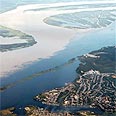
Indian summer
From the jungles of Peru to Ramla, Jewish immigrants of Indian descent prove nothing trumps need to connect with one's heritage
This is a story of discovery. The story of 700 Indians, descendants of Jewish tradesmen who emigrated from Morocco to the Amazonas more than 150 years ago, who reconnected with their Jewish heritage and came to Israel.
Since the summer of 2005, hundreds of Jewish Indians have made their way from the jungles of Brazil to Israel. Originally settling in Beersheba, those immigrating over the last couple of year have made their home in Ramla.
But how did they come to be in the Amazonas? And what's Morocco have to do with it? Well, as the story goes, about 150 year ago, when the world's rubber industry was starting to develop, several Moroccan Jews – rubber tradesmen – arrived in South America.
They made their way up the Amazonas River, from Brazil to Peru, where they were able to cultivate rubber trees – or as they are called - Hevea Brasiliensis – the Pará rubber tree.
In those days, foreigners found it difficult to travel safely though the jungles and the native Indians were their guides. The Jewish merchants had no wives, and ended up marrying the local Indian women.
Mixed flavors
Flashing forwards, up until 20 years ago, Judaism was nothing more than a distant memory for this community, living through a handful of religious customs practices by a few of the families living in the Amazonas.
But then, a chance encounter changed it all: "In the 1980s, a Jewish family, the Aderi's, came to our village and every time my father would go pass their store, the owner would say 'hola senior Messiah' – he recognized our name as a Jewish one," Kelly Messia, an Indian who came to Israel three years ago, told Yedioth Ahronoth Monday.
The village had no synagogue, but the Messia family became an inseparable part of the Aderi's Shabbat practices. "All of a sudden we began discovering our Jewish roots. We're mixed Indians: My mother's father came from Brazil and his ancestors came from Spain, and may have been decedents of the Spanish Jews forces to convert.
"My husband's name is Italian and his ancestors were apparently Italian Jews, so actually, we're all over the place," she said.
Most of the Indians who came to Israel are decedents of the Levy family, which lived in the jungle village of Kontmana. Sandro Levy believes there some 150 of his kin living in Ramla today.
"My grandfather came to Peru from Morocco in the 19th century," he said. "My mother always told us that there were other Jewish families in our village, all with Moroccan roots."
Some of the Jewish Indians tell of families fleeing to the jungles for fear of anti-Semitic persecution in Europe; some trace their roots back to the Jewish community in France, but the majorities are decedents of Moroccan Jews; and all of them tell tales of modern persecution.
Burden of proof
So how does one reconnect with one's heritage? "Everyone wants to know about his roots," said Kelly's daughter, Baji, 25. "When I was a little girl we didn’t talk about being Jewish – my grandmother kept the family history a secret. Everyone in South America is Catholic and we didn't want to be different.
"It was only when I was 20 that we began observing some of the customs and we tried to get in touch with the Jewish community in Peru, to see if we can come to Israel."
The Jewish community in Lima, however, was less than enthused. "They told us there was absolutely no way we could be Jewish. The Orthodox rabbis wouldn't even talk to us," said Baji. "Only one Conservative rabbi, Rabbi Bronstein, paid any attention to us and after meeting with us he agreed to perform a conversion."
Word of the conversion soon swept the villages and in late 2004, three Conservative rabbis – from Chile, Argentina and New York – came to the village of Ikitos and formed a rabbinical court of conversions.
In the lack of a proper mikveh, the ritual of purity – the immersing in water – took place in a nearby river, closely supervised by the rabbis. By the summer of 2005, they were all on their way to Israel.
Homecoming
The Indian immigration became a project near and dear to the Ramla Municipality. "These are motivated people, who want to make a place for themselves here," Amir Vider, head of the Ramla Municipality immigration absorption department, told Yedioth Ahronoth.
"They are a welcome addition to Israel, and a most welcome one to Ramla."
The City has lunched a special initiative – Project Parents – to help ease the Indians' way into Israeli society. As part of the project, the City assigns each family with a "parent", who takes them through everything – from meeting them at the arrival's gate at Ben Gurion International Airport, through finding an apartment, signing up for health care and registering the kids in schools to grocery shopping.
"They come from a completely different culture and they need time to get used to everything," explained Vider. "Once they feel comfortable, they want the rest of their family to come to Ramla as well."
The once thing that angers the new community is the constant innuendo implying they only came to Israel in order to better their financial status.
"We love this country," states Sandro Levy. "Both my brothers are serving in the army, and we all have jobs. We're happy here."
Mary, his mother, agrees: "We're Zionists," she said. "Unlike the first olim that got here and found nothing, we've found everything. Of course we're happy here – this is paradise."










